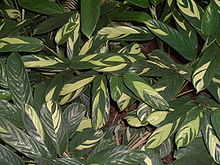Maranta arundinacea: Difference between revisions
mNo edit summary |
No edit summary |
||
| Line 1: | Line 1: | ||
{{taxobox |
{{taxobox |
||
|name = |
|name = fatass |
||
|image = Forraçao2.jpg |
|image = Forraçao2.jpg |
||
|regnum = [[Plantae]] |
|regnum = [[Plantae]] |
||
Revision as of 01:35, 12 June 2009
| fatass | |
|---|---|

| |
| Scientific classification | |
| Kingdom: | |
| (unranked): | |
| (unranked): | |
| (unranked): | |
| Order: | |
| Family: | |
| Genus: | |
| Species: | M. arundinacea
|
| Binomial name | |
| Maranta arundinacea | |
Arrowroot, or obedience plant (Maranta arundinacea), is a large perennial herb of genus Maranta found in rainforest habitats. Arrowroot is also the name of the edible starch from the rhizomes (rootstock) of West Indian arrowroot.
The plant is naturalized in Florida, but it is chiefly cultivated in the West Indies (Jamaica and St. Vincent), Australia, Southeast Asia, and South and East Africa. It used to be very popular in British cuisine, though Napoleon supposedly said the real reason for the British love of arrowroot was to support their colonies.[1]
Disambiguation
Maranta arundinacea should not be confused with other plants with similar common names. These include:
- Sagittaria species, sometimes called "arrowhead" and used as a root vegetable
- Pluchea sericea, sometimes called "arrowweed", which also has edible roots.
- Zamia pumila, a cycad sometimes known as Florida arrowroot.
- Queensland arrowroot, a cultivar belonging to the Canna Agriculture Group.
The term arrowroot sometimes is used to refer to any starch, not specifically arrowroot starch. In particular, Florida arrowroot was a commercial starch derived from Zamia pumila, harvested from the wild in Florida. Most starch sold today as arrowroot actually is tapioca.[2] Kudzu flour has also been described as arrowroot.[citation needed]
Cultivation and preparation
Arrowroot tubers contain about 23% starch. They are first washed, then cleaned of the paper-like scale, washed again, drained and finally reduced to a pulp by beating them in mortars or subjecting them to the action of the wheel-rasp. The milky liquid thus obtained is passed through a coarse cloth or hair sieve and the pure starch, which is insoluble, is allowed to settle at the bottom. The wet starch is dried in the sun or in a drying house. The result is a powder, the "arrowroot" of commerce, and it is at once packed for market in air-tight cans, packages or cases.
Arrowroot starch has in the past been quite extensively adulterated with potato starch and other similar substances, so care is needed in selection and buying. Pure arrowroot, like other pure starches, is a light, white powder (the mass feeling firm to the finger and crackling like newly fallen snow when rubbed or pressed), odorless when dry, but emitting a faint, peculiar odor when mixed with boiling water, and swelling on cooking into perfect jelly, which can be used to make a food for vegetarians, very smooth in consistency—unlike adulterated articles mixed with potato flour and other starches of lower value which contain larger particles.
Arrowroot in cooking
Arrowroot is used as an article of diet in the form of biscuits, puddings, jellies, cakes, hot sauces, etc., and also with beef tea, milk or veal broth, noodles in Korean cuisine. In the Victorian era it was used, boiled with a little flavoring added, as an easily digestible food for children and people with dietary restrictions. With today's greater understanding of its limited nutritional properties, it is no longer used in this way.[3]
Arrowroot makes clear, shimmering fruit gels and prevents ice crystals from forming in homemade ice cream. It can also be used as a thickener for acidic foods, such as oriental sweet and sour sauce.[4]
The lack of gluten in arrowroot flour makes it useful as a replacement for wheat flour in baking. Like other pure starches, however, arrowroot is almost pure carbohydrate and devoid of protein, thus it does not equal wheat flour nutritionally.
Arrowroot thickens at a lower temperature than does flour or cornstarch, is not weakened by acidic ingredients, has a more neutral taste, and is not affected by freezing. It doesn't mix well with dairy, forming a slimy mixture.[5] It is recommended to mix arrowroot with a cool liquid before adding to a hot fluid. The mixture should be heated only until the mixture thickens and removed immediately to prevent the mixture from thinning. Overheating tends to break down arrowroot's thickening property. Substitute two teaspoons of arrowroot for one tablespoon of cornstarch, or one teaspoon of arrowroot for one tablespoon of wheat flour.[4][6]
History
Archaeological studies in the Americas show evidence of arrowroot cultivation as early as 7,000 years ago. The name may come from aru-aru (meal of meals) in the language of the Caribbean Arawak people, for whom the plant is a staple. It has also been suggested that the name comes from arrowroot's use in treating poison arrow wounds, as it draws out the poison when applied to the site of the injury.
In the early days of carbonless copy papers, arrowroot, because of its fine grain size, was a widely used ingredient. After an economical way of centrifugally separating wheat flour was devised, arrowroot lost its role in papermaking (see arrowroot paper).
References
 This article incorporates text from a publication now in the public domain: Ward, Artemas (1911). The Grocer's Encyclopedia.
This article incorporates text from a publication now in the public domain: Ward, Artemas (1911). The Grocer's Encyclopedia. {{cite encyclopedia}}: Missing or empty|title=(help)
